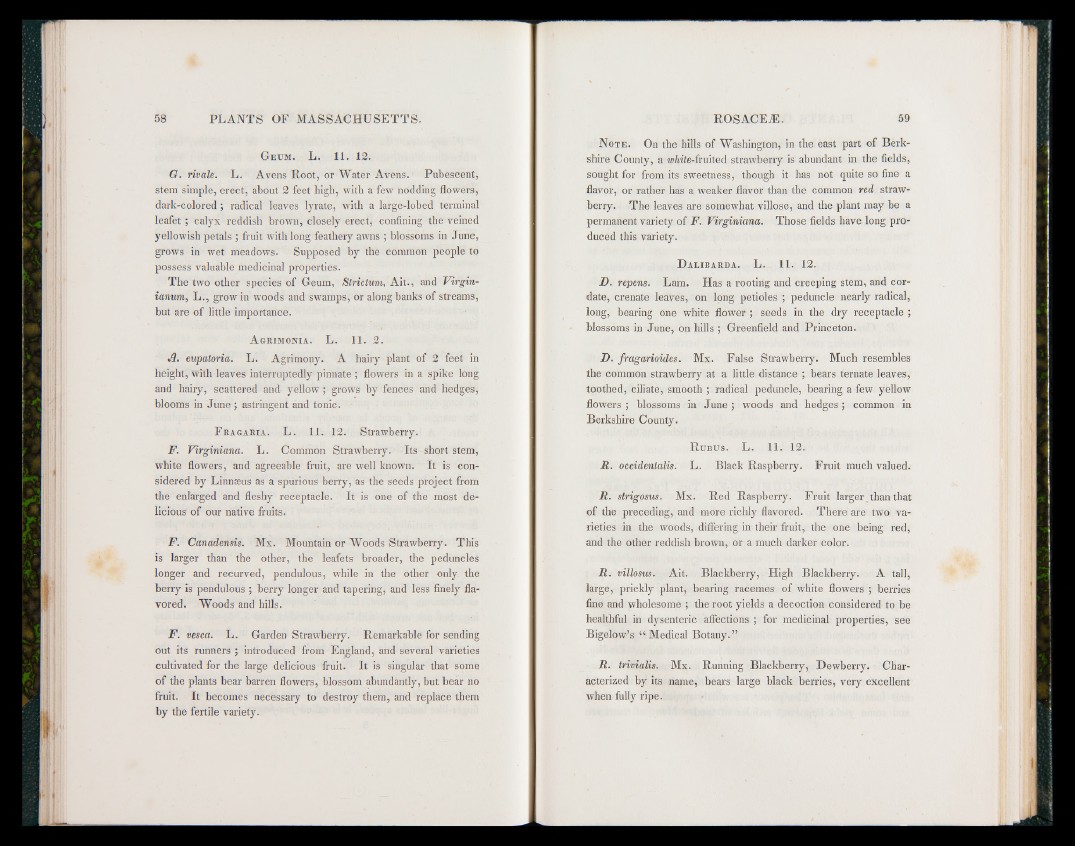
G eum. L. 11. 12.
G. rivale. L. Avens Root, or Water Avens. Pubescent,
stem simple, erect, about 2 feet high, with a few nodding flowers,
dark-colored ; radical leaves lyrate, with a large-lobed terminal
leafet ; calyx reddish brown, closely erect, confining the veined
yellowish petals ; fruit with long feathery awns ; blossoms in June,
grows in wet meadows. Supposed by the common people to
possess valuable medicinal properties.
The two other species of Geum, Strictum, Ait., and Virgin-
ianum, L., grow in woods and swamps, or along banks of streams,
but are of little importance.
A grimonia. L. 11. 2.
A. eupatoria. L. Agrimony. A hairy plant of 2 feet in
height, with leaves interruptedly pinnate; flowers in a spike long
and hairy, scattered and yellow; grows by fences and hedges,
blooms in June ; astringent and tonic.
F ragaria. L . 11. 12. Strawberry.
F. Virginiana. L. Common Strawberry. Its short stem,
white flowers, and agreeable fruit, are well known. It is considered
by Linnaeus as a spurious berry, as the seeds .project from
the enlarged and fleshy receptacle. It is one of the most delicious
of our native fruits.
F. Canadensis. Mx. Mountain or Woods Strawberry. This
is larger than the other, the leafets broader, the peduncles
longer and recurved, pendulous, while in the other only the
berry is pendulous ; berry longer and tapering, and less finely flavored.
Woods and hills.
F. vesca. L. Garden Strawberry. Remarkable for sending
out its runners ; introduced from England, and several varieties
cultivated for the large delicious fruit. It is singular that some
of the plants bear barren flowers, blossom abundantly, but bear no
fruit. It becomes necessary to destroy them, and replace them
by the fertile variety.
N ote. On the hills of Washington, in the east part of Berkshire
County, a w/rife-fruited strawberry is abundant in the fields,
sought for from its sweetness, though it has not quite so fine a
flavor, or rather has a weaker flavor than the common red strawberry.
The leaves are somewhat villose, and the plant may be a
permanent variety of F.. Virginiana. Those fields have long produced
this variety.
D alibarda. L. 11. 12.
D. repens. Lam. Has a rooting and creeping stem, and cordate,
crenate leaves, on long petioles ; peduncle nearly radical,
long, bearing one white flower ; seeds in the dry receptacle ;
blossoms in June, on hills ; Greenfield and Princeton.
D. fragarioides. Mx. False Strawberry. Much resembles
the common strawberry at a little distance ; bears ternate leaves,
toothed, ciliate, smooth ; radical peduncle, bearing a few yellow
flowers ; blossoms in June ; woods and hedges; common in
Berkshire County.!
R ubus. L. 11. 12.
R. occidentalis. L. Black Raspberry. Fruit much valued.
R. strigosus. Mx. Red Raspberry. Fruit larger than that
of the preceding, and more richly flavored. There are two varieties
in the woods, differing in their fruit, the one being red,
and the other reddish brown, or a much darker color.
R . villosus. Ait. Blackberry, High Blackberry. A tall,
large, prickly plant, bearing racemes of white flowers ; berries
fine and wholesome ; the root yields a decoction considered to be
healthful in dysenteric affections ; for medicinal properties, see
Bigelow’s “ Medical Botany.”
R. trivialis. Mx. Running Blackberry, Dewberry. Characterized
by its name, bears large black berries, very excellent
when fully ripe.